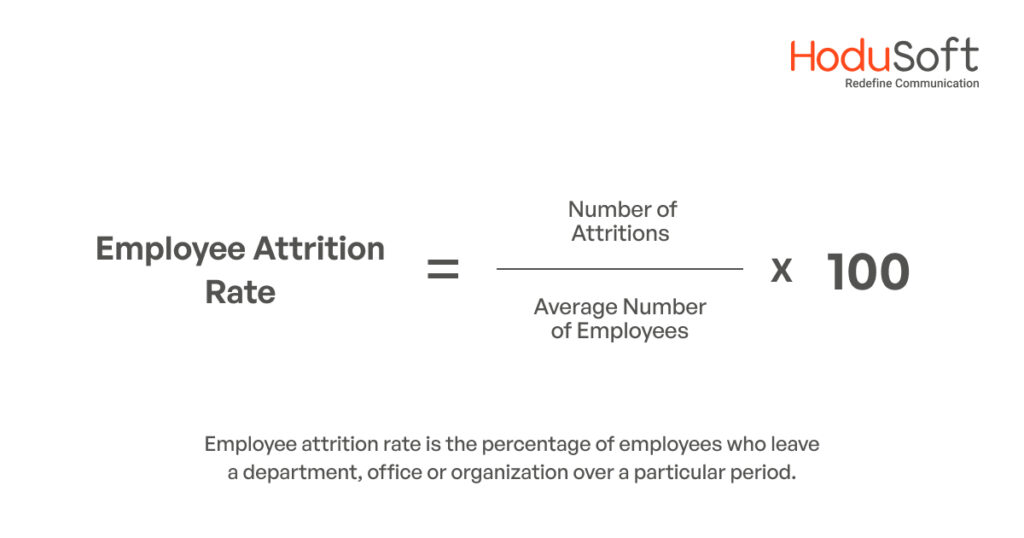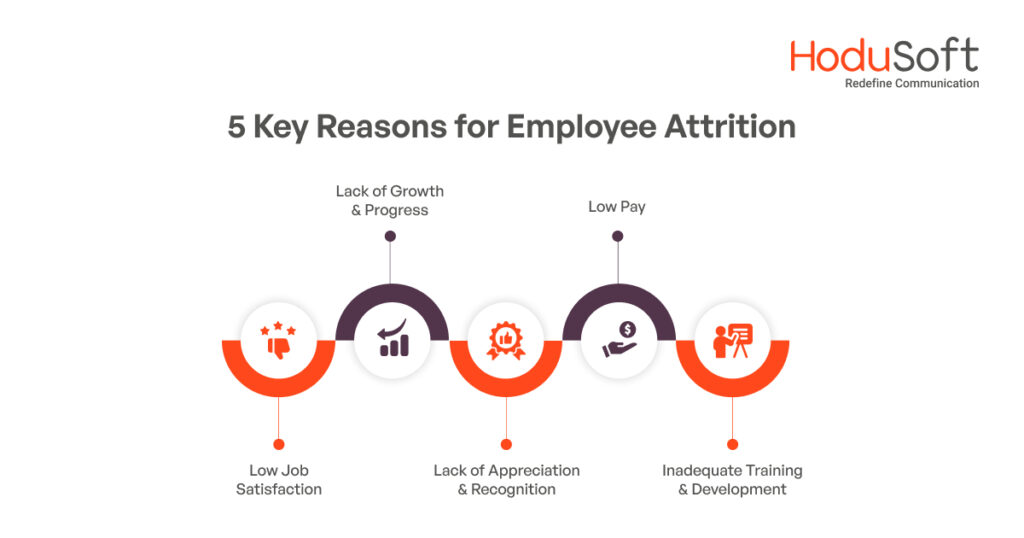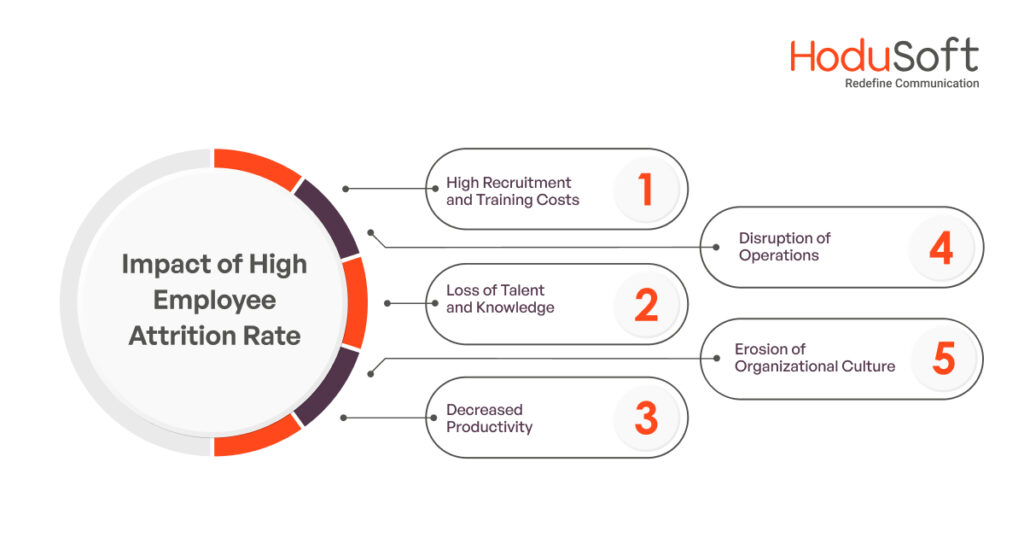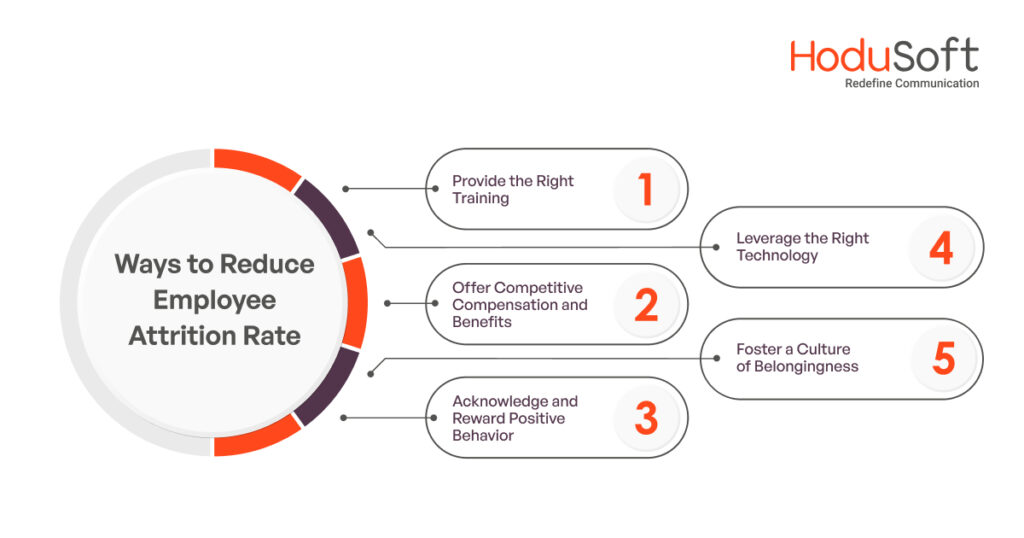Employee Attrition : Types, Reasons, Effects, and Strategies to Control
What comes to your mind when you read the term “employee attrition?” Big Quit? The Great Resignation? Mass Layoffs? Quite Quitting? Recession?
Even though, in the last few years, employee attrition has become a huge concern for many organizations, particularly the ones in the call and contact center industry, it hasn’t always had a negative connotation.
In some cases, employee attrition was good for businesses due to various strategic and economic reasons. But things changed after the 2020 global pandemic. While many companies had to let go a huge chunk of their employees, a large number of people left their jobs owing to health and personal reasons.
In 2021, the term “The Great Resignation,” coined by psychologist Anthony Klotz, became part of the business lexicon. With a recession looming over many major economies, the rate of employee attrition is anticipated to deteriorate further. But the situation is not all gloom and doom. With the right knowledge and effective strategies, companies of all sizes across sectors can manage employee attrition.
This blog post does a deep dive into employee attrition and explains everything from the definition of the term to strategies to control it. So, without further ado, let’s dive straight into the blog post.
- What Is Employee Attrition?
- What Is Employee Attrition Rate?
- What Is the Good Employee Attrition Rate?
- Statistics on Employee Attrition in the Call and Contact Center Industry
- Types of Employee Attrition
- Key Reasons for Employee Attrition
- Effects of Employee Attrition
- Strategies to Reduce High Employee Attrition Rate
What Is Employee Attrition?
The term employee attrition is used to describe the reduction of employee pool from a department, office, or organization. The word attrition was borrowed from the Mediaeval Latin word ‘attritio,’ which means wearing away.
Employee attrition is sometimes confused with employee turnover but both are not the same and must not be used interchangeably. The former is a long-term metric while the latter is a short-term one.
Attrition is caused by a lot of factors such as structural changes, resignations, and retirement. The dent caused by attrition is not immediately filled up. However, the vacancies caused by employee turnover can be addressed immediately by rehiring.
What Is Employee Attrition Rate?
The formula to calculate the employee attrition rate is the actual number of employees quitting their jobs divided by the average number of employees multiplied by 100.

Employee Attrition Rate = Number of Attritions / Average Number of Employees x 100 |
What Is the Good Employee Attrition Rate?
As per several leading experts from various industries, an employee attrition rate of 10 percent or less is good for organizations.
An attrition rate of 20-30 percent is high. A rate of above 30 percent is very high.
Statistics on Employee Attrition in the Call and Contact Center Industry
A 2022 NICE WEM Global Survey that surveyed 400 managers and agents at call centers across the U.K. and the U.S. revealed the average attrition rate for call centers in 2021 stood at 42 percent.
As per the 2022 Cresta Insights Report, employee attrition at customer call centers that focus on customer care and support is nearly 1.3 times the average annual attrition rate in the United States.
As per the profile, the attrition rate is:
- For call and contact centers handling all types of communication: 83.7 percent
- For call and contact centers handling only sales calls and messages: 79.8 percent
- For call and contact centers handling only customer care or support: 87.6 percent
As per the same survey, the yearly costs to backfill a 100-seater call center are:
- For call and contact centers handling all types of communication: USD 800,000–USD 1.7 million
- For call and contact centers handling only sales calls and messages: USD 800,000– USD 1.6 million
- For call and contact centers handling only customer care or support: USD 900,000–USD 1.8 million
As per research by Sharpen CX, the cost to replace a call center agent is between USD 10,000–and USD 20,000.
What is First Call Resolution (FCR): A Complete Guide
Types of Employee Attrition
Employee attrition comes in many forms and types. Some can be prevented and some cannot be. For call and contact centers, knowing different types of employee attrition is crucial as it would help in identifying which ones can be controlled and which ones cannot be.

1. Voluntary Attrition
As the name suggests, voluntary attrition means when employees quit their jobs voluntarily. There are many reasons for this type of attrition such as better job opportunities, plans to change careers, find work-life balance, and more.
More often than not, organizations can limit voluntary attrition with a little effort.
2. Attrition Due to Retirement
This type of attrition happens after employees reach a certain age, for instance, 60 or above. Even though attrition due to retirement does not often leave a massive dent in most organizations, it still can impact those companies where a majority of employees are close to the retirement age.
This is beyond the control of companies that operate in countries with a mandatory retirement age.
3. Involuntary Attrition
As the name suggests, involuntary employee attrition happens when employees quit their jobs involuntarily. There are two types of involuntary attrition—termination and layoffs.
The former happens due to employees’ reasons such as behavioral issues, low or non-performance, lack of job-skill match, and others. The latter happens due to economic conditions or strategic reasons such as changing market conditions, recession or depression, organizational restructuring, and winding up of business operations in a country, among others.
4. Demographic Attrition
This type of attrition happens when employees of a particular demographic quit their jobs in huge numbers. For instance, a large number of employees of a particular gender leaving in hordes is an example of demographic attrition.
When a substantial number of employees of a particular ethnicity or employees belonging to a particular age group (excluding retirement age) leave an organization, that is an example of demographic attrition.
5. Internal Attrition
When employees from one department quit their jobs to join another department in the same organization, then it is known as internal attrition. This type of attrition is more common in large organizations and the switch is usually from low-wage, low-value jobs to high-wage and high-salary ones.
The increased focus on upskilling and availability of various courses also play a role in internal attrition in the present age.
Key Reasons for Employee Attrition
Employee attrition happens for many reasons. Some of the major reasons are:

1. Low Job Satisfaction
A survey conducted by Gallup revealed that low job satisfaction is one of the major factors responsible for voluntary attrition. As per another stat, dissatisfied employees are three times more likely to quit. Not just that. One in three dissatisfied employees are planning to leave their job, the data reveals.
2. Lack of Appreciation & Recognition
Just as the right compensation plays an important role in driving employees’ performance, so does recognition and appreciation. Not just that. They play a major role in preventing attrition and retaining top talent. As per a study, 46 percent of respondents quit their jobs due to a lack of recognition and appreciation. According to another study, 87 percent of employees feel that meaningful recognition impacts job satisfaction.
3. Inadequate Training and Development
Can ignoring the training and development of employees result in higher attrition rates? The answer to the question is a resounding yes. According to recent data, 41 percent of respondents said they are planning to quit their jobs within one year due to lack of training.
4. Lack of Growth and Progress
As per a McKinsey report, 40 percent of employees are quitting their jobs due to a lack of career advancement. Another survey found that a considerable number of employees from leading English-speaking countries are leaving their jobs due to a lack of prospects for career advancement. As per the poll, 41 percent of employees in the U.K., the U.S., Australia, Canada, Singapore, and India are quitting their jobs because of insufficient prospects for upward mobility.
5. Low Pay
If we go by Maslow’s need hierarchy theory, the pay package is more of a hygiene factor than a motivator for employees. Its absence will cause the best of workers to leave. A research conducted by Pew Research Center found that 63 percent of respondents said low pay was the key reason they resigned from their job in 2021.
How High Employee Attrition Rate Impacts Organizations?
High employee attrition can have an adverse impact on organizations in many ways. Some of them are:

1. High Recruitment and Training Costs
More often than not, replacing an existing employee is much more expensive than retaining him or her. An organization may save some money on salary and benefits but the recruitment and training costs will be extremely high. As per a study conducted by Gallup, the cost of replacing an employee can be up to two times their annual salary.
2. Loss of Talent and Knowledge
Even if an organization manages to replace its outgoing employees, can it replace their in-depth knowledge of products and processes, unique skills, and years of experience? No, it cannot. When skillful and talented employees leave, they take their skills, knowledge, and experience with them.
3. Decreased Productivity
As new employees need considerable time to be trained before they start to perform, an organization’s productivity declines dramatically. The workloads shift to experienced employees, which can lead to burnout and reduced morale.
4. Disruption of Operations
Be it voluntary attrition or involuntary ones, when employees quit organizations, it has an adverse effect on the business operations. It not only impacts the overall performance of remaining employees but also the quality of the product or service as well as customer experience.
5. Erosion of Organizational Culture
An organization’s culture is created by its employees, particularly the experienced and senior ones. If the employee attrition rate is consistently high in an organization then it is more likely to witness a massive deterioration in its culture. When the organizational culture takes a hit, so does innovation and creativity.
How Can Organizations Reduce Employee Attrition Rate?
“You cannot stop employees from leaving unless you have strategies to make them stay.”
This quote is perfect for every organization that is looking for ways to reduce the rate of voluntary employee attrition. Here are some effective ways to reduce employee attrition:

1. By Providing the Right Training
The right training can offset many reasons responsible for voluntary attrition. When employees receive the right training, they are more likely to perform better. It not only enhances job satisfaction but also their career prospects and the ability to command a higher remuneration.
2. By Offering Competitive Compensation and Benefits
As discussed in the last point the causes behind employee attrition, salary, and perks are not factors of motivation but a hygiene factor. The practice of good hygiene doesn’t necessarily improve health and immunity, but the absence of it can deteriorate both. Likewise, paying good salaries may not guarantee the retention of the best employees, but not paying the right compensation can drive employees to leave.
3. By Acknowledging and Rewarding Positive Behavior
This one is extremely important. Noted educationist Margaret Cousins rightly said, “Appreciation can make a day, even change a life.” When organizations recognize and reward employees’ positive actions and behavior, it not only makes the latter feel valued but also reinforces the actions and behavior.
4. Leveraging the Right Technology
In today’s digital age, leveraging the right technology can make a huge difference when it comes to retaining employees and reducing voluntary attrition. Let’s take the example of the call center industry, which is infamous for its high employee attrition rate.
When a call or contact center invests in a sophisticated tech stack such as advanced contact center software and omnichannel CX suite, it can empower agents to work efficiently and effectively. The real-time analytics and reporting tools can help it monitor various key performance indicators.
5. Fostering a Culture of Belongingness
Employees who feel a sense of belonging tend to stay engaged and invested in an organization. When an organization fosters a sense of belongingness, it not only creates a strong culture but also makes employees feel that they are an integral part of the organization.
Everything Said and Done,
No matter how hard organizations try, they cannot eliminate employee attrition completely. A certain percentage of attrition rate is inevitable. However, if the rate of employee attrition is higher than 25 to 30 percent, an organization must do something to bring it down.
At HoduSoft, we believe that call and contact centers can reduce their employee attrition rate by leveraging the right technology, such as call center software and HoduCC Omnichannel CX suite.
Our call and contact center software solutions are designed not just to deliver an exceptional customer experience but also to increase employees’ efficiency and productivity. If you want to try our omnichannel CX suite and call and contact center software, contact us today and book a free demo.



